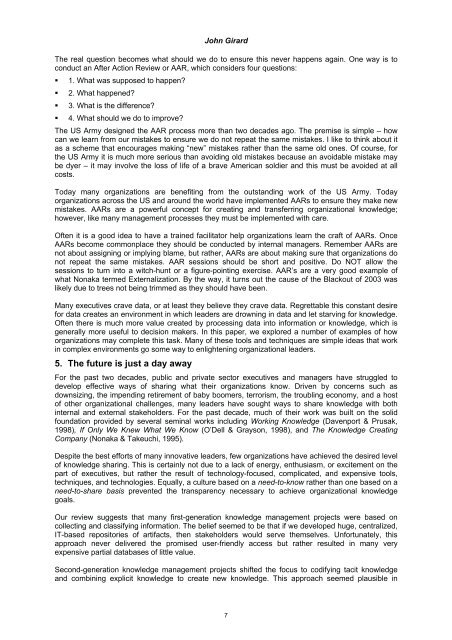Proceedings of the 3rd European Conference on Intellectual Capital
Proceedings of the 3rd European Conference on Intellectual Capital
Proceedings of the 3rd European Conference on Intellectual Capital
You also want an ePaper? Increase the reach of your titles
YUMPU automatically turns print PDFs into web optimized ePapers that Google loves.
John Girard<br />
The real questi<strong>on</strong> becomes what should we do to ensure this never happens again. One way is to<br />
c<strong>on</strong>duct an After Acti<strong>on</strong> Review or AAR, which c<strong>on</strong>siders four questi<strong>on</strong>s:<br />
1. What was supposed to happen?<br />
2. What happened?<br />
3. What is <str<strong>on</strong>g>the</str<strong>on</strong>g> difference?<br />
4. What should we do to improve?<br />
The US Army designed <str<strong>on</strong>g>the</str<strong>on</strong>g> AAR process more than two decades ago. The premise is simple – how<br />
can we learn from our mistakes to ensure we do not repeat <str<strong>on</strong>g>the</str<strong>on</strong>g> same mistakes. I like to think about it<br />
as a scheme that encourages making “new” mistakes ra<str<strong>on</strong>g>the</str<strong>on</strong>g>r than <str<strong>on</strong>g>the</str<strong>on</strong>g> same old <strong>on</strong>es. Of course, for<br />
<str<strong>on</strong>g>the</str<strong>on</strong>g> US Army it is much more serious than avoiding old mistakes because an avoidable mistake may<br />
be dyer – it may involve <str<strong>on</strong>g>the</str<strong>on</strong>g> loss <str<strong>on</strong>g>of</str<strong>on</strong>g> life <str<strong>on</strong>g>of</str<strong>on</strong>g> a brave American soldier and this must be avoided at all<br />
costs.<br />
Today many organizati<strong>on</strong>s are benefiting from <str<strong>on</strong>g>the</str<strong>on</strong>g> outstanding work <str<strong>on</strong>g>of</str<strong>on</strong>g> <str<strong>on</strong>g>the</str<strong>on</strong>g> US Army. Today<br />
organizati<strong>on</strong>s across <str<strong>on</strong>g>the</str<strong>on</strong>g> US and around <str<strong>on</strong>g>the</str<strong>on</strong>g> world have implemented AARs to ensure <str<strong>on</strong>g>the</str<strong>on</strong>g>y make new<br />
mistakes. AARs are a powerful c<strong>on</strong>cept for creating and transferring organizati<strong>on</strong>al knowledge;<br />
however, like many management processes <str<strong>on</strong>g>the</str<strong>on</strong>g>y must be implemented with care.<br />
Often it is a good idea to have a trained facilitator help organizati<strong>on</strong>s learn <str<strong>on</strong>g>the</str<strong>on</strong>g> craft <str<strong>on</strong>g>of</str<strong>on</strong>g> AARs. Once<br />
AARs become comm<strong>on</strong>place <str<strong>on</strong>g>the</str<strong>on</strong>g>y should be c<strong>on</strong>ducted by internal managers. Remember AARs are<br />
not about assigning or implying blame, but ra<str<strong>on</strong>g>the</str<strong>on</strong>g>r, AARs are about making sure that organizati<strong>on</strong>s do<br />
not repeat <str<strong>on</strong>g>the</str<strong>on</strong>g> same mistakes. AAR sessi<strong>on</strong>s should be short and positive. Do NOT allow <str<strong>on</strong>g>the</str<strong>on</strong>g><br />
sessi<strong>on</strong>s to turn into a witch-hunt or a figure-pointing exercise. AAR’s are a very good example <str<strong>on</strong>g>of</str<strong>on</strong>g><br />
what N<strong>on</strong>aka termed Externalizati<strong>on</strong>. By <str<strong>on</strong>g>the</str<strong>on</strong>g> way, it turns out <str<strong>on</strong>g>the</str<strong>on</strong>g> cause <str<strong>on</strong>g>of</str<strong>on</strong>g> <str<strong>on</strong>g>the</str<strong>on</strong>g> Blackout <str<strong>on</strong>g>of</str<strong>on</strong>g> 2003 was<br />
likely due to trees not being trimmed as <str<strong>on</strong>g>the</str<strong>on</strong>g>y should have been.<br />
Many executives crave data, or at least <str<strong>on</strong>g>the</str<strong>on</strong>g>y believe <str<strong>on</strong>g>the</str<strong>on</strong>g>y crave data. Regrettable this c<strong>on</strong>stant desire<br />
for data creates an envir<strong>on</strong>ment in which leaders are drowning in data and let starving for knowledge.<br />
Often <str<strong>on</strong>g>the</str<strong>on</strong>g>re is much more value created by processing data into informati<strong>on</strong> or knowledge, which is<br />
generally more useful to decisi<strong>on</strong> makers. In this paper, we explored a number <str<strong>on</strong>g>of</str<strong>on</strong>g> examples <str<strong>on</strong>g>of</str<strong>on</strong>g> how<br />
organizati<strong>on</strong>s may complete this task. Many <str<strong>on</strong>g>of</str<strong>on</strong>g> <str<strong>on</strong>g>the</str<strong>on</strong>g>se tools and techniques are simple ideas that work<br />
in complex envir<strong>on</strong>ments go some way to enlightening organizati<strong>on</strong>al leaders.<br />
5. The future is just a day away<br />
For <str<strong>on</strong>g>the</str<strong>on</strong>g> past two decades, public and private sector executives and managers have struggled to<br />
develop effective ways <str<strong>on</strong>g>of</str<strong>on</strong>g> sharing what <str<strong>on</strong>g>the</str<strong>on</strong>g>ir organizati<strong>on</strong>s know. Driven by c<strong>on</strong>cerns such as<br />
downsizing, <str<strong>on</strong>g>the</str<strong>on</strong>g> impending retirement <str<strong>on</strong>g>of</str<strong>on</strong>g> baby boomers, terrorism, <str<strong>on</strong>g>the</str<strong>on</strong>g> troubling ec<strong>on</strong>omy, and a host<br />
<str<strong>on</strong>g>of</str<strong>on</strong>g> o<str<strong>on</strong>g>the</str<strong>on</strong>g>r organizati<strong>on</strong>al challenges, many leaders have sought ways to share knowledge with both<br />
internal and external stakeholders. For <str<strong>on</strong>g>the</str<strong>on</strong>g> past decade, much <str<strong>on</strong>g>of</str<strong>on</strong>g> <str<strong>on</strong>g>the</str<strong>on</strong>g>ir work was built <strong>on</strong> <str<strong>on</strong>g>the</str<strong>on</strong>g> solid<br />
foundati<strong>on</strong> provided by several seminal works including Working Knowledge (Davenport & Prusak,<br />
1998), If Only We Knew What We Know (O’Dell & Grays<strong>on</strong>, 1998), and The Knowledge Creating<br />
Company (N<strong>on</strong>aka & Takeuchi, 1995).<br />
Despite <str<strong>on</strong>g>the</str<strong>on</strong>g> best efforts <str<strong>on</strong>g>of</str<strong>on</strong>g> many innovative leaders, few organizati<strong>on</strong>s have achieved <str<strong>on</strong>g>the</str<strong>on</strong>g> desired level<br />
<str<strong>on</strong>g>of</str<strong>on</strong>g> knowledge sharing. This is certainly not due to a lack <str<strong>on</strong>g>of</str<strong>on</strong>g> energy, enthusiasm, or excitement <strong>on</strong> <str<strong>on</strong>g>the</str<strong>on</strong>g><br />
part <str<strong>on</strong>g>of</str<strong>on</strong>g> executives, but ra<str<strong>on</strong>g>the</str<strong>on</strong>g>r <str<strong>on</strong>g>the</str<strong>on</strong>g> result <str<strong>on</strong>g>of</str<strong>on</strong>g> technology-focused, complicated, and expensive tools,<br />
techniques, and technologies. Equally, a culture based <strong>on</strong> a need-to-know ra<str<strong>on</strong>g>the</str<strong>on</strong>g>r than <strong>on</strong>e based <strong>on</strong> a<br />
need-to-share basis prevented <str<strong>on</strong>g>the</str<strong>on</strong>g> transparency necessary to achieve organizati<strong>on</strong>al knowledge<br />
goals.<br />
Our review suggests that many first-generati<strong>on</strong> knowledge management projects were based <strong>on</strong><br />
collecting and classifying informati<strong>on</strong>. The belief seemed to be that if we developed huge, centralized,<br />
IT-based repositories <str<strong>on</strong>g>of</str<strong>on</strong>g> artifacts, <str<strong>on</strong>g>the</str<strong>on</strong>g>n stakeholders would serve <str<strong>on</strong>g>the</str<strong>on</strong>g>mselves. Unfortunately, this<br />
approach never delivered <str<strong>on</strong>g>the</str<strong>on</strong>g> promised user-friendly access but ra<str<strong>on</strong>g>the</str<strong>on</strong>g>r resulted in many very<br />
expensive partial databases <str<strong>on</strong>g>of</str<strong>on</strong>g> little value.<br />
Sec<strong>on</strong>d-generati<strong>on</strong> knowledge management projects shifted <str<strong>on</strong>g>the</str<strong>on</strong>g> focus to codifying tacit knowledge<br />
and combining explicit knowledge to create new knowledge. This approach seemed plausible in<br />
7
















